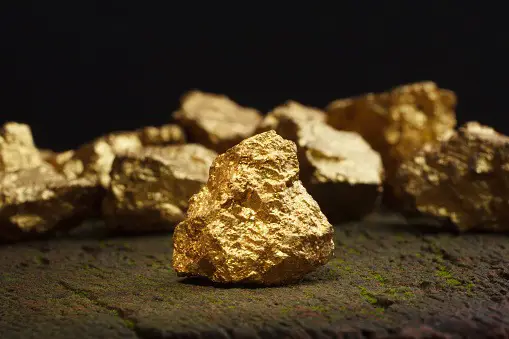Find Gold! The allure of finding gold in your own backyard is a dream that has captivated the hearts and minds of people for centuries. The idea of stumbling upon a hidden treasure right beneath your feet is undeniably exciting. The glimmering allure of gold has driven people to undertake incredible journeys, endure hardships, and even shape entire nations. While large-scale gold mining operations are often associated with remote regions and vast expanses of land, it is worth mentioning that small gold deposits can also be discovered on residential properties.
I. Research and Preparation to Find Gold
A. Before embarking on your gold prospecting adventure, it is essential to gather information about gold deposits in your region. Local geological surveys, mineral resource reports, and historical records can provide valuable insights into potential gold-bearing areas near you.
B. Studying geological maps and mineral surveys is an integral part of your preparation. These resources will help you identify areas with geological features that are favorable for gold deposition. Look for regions with known gold-bearing rock formations, fault lines, or areas that have experienced significant geological activity.
C. Researching historical gold mining activities in your area can uncover hidden clues and valuable information. Old mining records, newspaper archives, and personal accounts can shed light on previously successful gold mining operations and provide insights into potential gold-rich areas.
D. Understanding the characteristics and indicators of gold-bearing rocks is crucial for your prospecting efforts. Quartz veins, black sand, iron-stained rocks, and geological structures associated with gold mineralization are all worth investigating.

II. Obtaining the Necessary Equipment
A. A metal detector is an essential tool for gold detection. Choosing an appropriate model with high sensitivity to small gold particles is crucial. Look for detectors specifically designed for prospecting, as they offer features such as ground balancing and adjustable frequency to enhance your chances of success.
B. Basic digging tools such as a shovel and pickaxe are necessary for excavation purposes. Ensure you have the appropriate tools for breaking through rocks and extracting samples.
C. A sieve or classifier is used to sift through dirt and gravel, separating larger materials from smaller particles. This tool is invaluable for processing large amounts of material efficiently.
D. Small vials or containers are essential for collecting and storing your samples. These containers should be durable and securely sealed to prevent any loss of collected material.
III. Locating Potential Gold Deposits
A. Identifying geological features that are favorable for gold deposition is crucial. Look for areas where ancient rivers once flowed, such as old riverbeds or terrace gravels, as these locations have a higher likelihood of containing placer gold deposits.
B. Search for known gold-bearing rock formations or outcrops in your area. Geological maps and local knowledge can help you identify these areas, which have a higher probability of containing gold.
C. Examine local streams and rivers for signs of placer gold deposits. Look for gold flakes or nuggets in the sediment, especially in areas with slow-moving or stagnant water, such as inside bends of rivers or behind large boulders.
D. Indicators such as quartz veins, black sand (which often contains magnetite), and other minerals associated with gold can serve as valuable clues. These indicators can be found in rock outcrops or along the banks of waterways.
read also: How to Find Gemstones in Your Backyard – DIY Project
IV. Conducting Fieldwork (Find Gold)
A. It is essential to obtain permission from the property owner before conducting any prospecting activities. Respect private property boundaries and follow any regulations or restrictions that may be in place.
B. Begin your fieldwork by conducting a visual inspection of the area. Look for signs of previous mining activities, geological formations, and any indicators of gold-bearing rocks.
C. Use your metal detector to scan the ground for gold signals. Walk slowly and systematically, sweeping the detector back and forth in a controlled manner. Pay attention to any significant changes in the detector’s readings, which could indicate the presence of gold or other metallic objects.
D. To further confirm potential gold deposits, it is necessary to dig test holes or trenches to collect samples. Focus on areas where your metal detector has detected strong signals or where geological indicators suggest gold-bearing rocks may be present. Extract samples from different depths, as gold can accumulate at various levels within the soil or bedrock.
source: Courtesy of Youtube
V. Sample Analysis to Find Gold
A. Once you have collected your samples, it is time to wash the material in a pan or sluice box. Submerge the material in water and agitate it, allowing the lighter materials to wash away while the heavier gold particles settle at the bottom.
B. Use a magnifying glass to examine the contents of your pan. Look for bright, metallic specks or flakes that resemble gold. While some minerals may resemble gold, the distinct shine and color of genuine gold will distinguish it from other substances.
C. Conduct basic tests to determine if the gold is genuine. One commonly used test is the streak test, where you rub the sample against a hard, unglazed surface. Genuine gold will leave a golden-yellow streak, while other minerals will leave different colored streaks.
D. For a more accurate analysis, consider sending your samples to a professional laboratory specializing in mineral identification. These labs have advanced techniques such as X-ray fluorescence (XRF) analysis or fire assay, which provide precise results regarding the gold content of your samples.
read also: How to Make Gold Paint: Make Shiny Golden Color for Any Purposes
VI. Environmental and Legal Considerations
A. Adhering to local regulations and laws is of utmost importance when engaging in prospecting activities. Familiarize yourself with the specific laws and regulations governing prospecting and mining in your region, including any permits or licenses that may be required.
B. Practice responsible environmental stewardship throughout your search. Minimize your impact on the environment by avoiding sensitive areas, properly disposing of waste, and refraining from using harmful chemicals or methods that may harm the ecosystem.
C. Be aware of potential hazards and take necessary safety precautions. Depending on your location, this may include being mindful of wildlife encounters, avoiding unstable cliffs or rock faces, and using appropriate safety gear such as gloves, boots, and eye protection.
D. Always respect private property boundaries and obtain proper permissions before conducting any prospecting activities on someone else’s land. Seek the landowner’s consent and ensure you are not infringing upon their rights.
VII. Documenting and Reporting Findings
A. Keeping a detailed log of your activities, locations, and findings is essential for future reference. Note the dates, locations, geological observations, and any significant discoveries you make during your prospecting journey. This log will serve as a valuable resource and contribute to the overall knowledge of gold deposits in your region.
B. Take photographs to visually document your findings. Capture the geological features, samples, and any notable gold particles or nuggets you discover. These visual records will enhance your documentation and help you share your experiences with others.
C. Share your experiences and findings with local geological or historical societies. These organizations can provide valuable insights and potentially connect you with other enthusiasts or experts in the field. Additionally, contributing your findings to the collective knowledge base helps advance the understanding of gold deposits in your region.
read also: 20 Best Gold Wall Decor – Gold Accents & Items For Your Lovely Home
VIII. Further Exploration and Collaboration about (Find Gold)
A. Consider joining local prospecting or mining clubs. These organizations offer opportunities for networking, learning from experienced prospectors, and participating in group outings to areas with potential gold deposits. Collaborating with fellow enthusiasts can enhance your prospecting skills and increase your chances of success.
B. Attend workshops or seminars dedicated to gold prospecting. These educational events provide valuable insights into prospecting techniques, geological knowledge, and the latest tools and technologies. They are excellent opportunities to expand your knowledge and refine your prospecting skills.
C. Collaborate with other enthusiasts or experts in the field. Building connections and sharing knowledge with like-minded individuals can significantly enhance your prospecting endeavors. By combining your skills and resources, you can explore larger areas, conduct more in-depth research, and increase the overall effectiveness of your prospecting efforts.
IX. Conclusion
A. In conclusion, the allure of finding gold in your own backyard is an exhilarating pursuit that combines adventure, discovery, and the potential for valuable treasure. By following the outlined steps, you can embark on a successful gold prospecting adventure.
B. It is important to remember that gold prospecting requires patience, perseverance, and a commitment to responsible practices. Not every expedition will yield significant results, but each experience contributes to your knowledge and understanding of gold deposits in your region.
C. While there are potential pros and cons to consider, the thrill of uncovering gold, even in small quantities, can be a rewarding experience. Pros include the excitement of discovery, the potential for valuable finds, and the opportunity to contribute to scientific knowledge. However, cons include the costs associated with equipment, the potential for minimal or no findings, and the need to adhere to legal and environmental regulations.
In the end, the journey of gold prospecting goes beyond the pursuit of material wealth. It is about connecting with nature, exploring the Earth’s geological wonders, and embracing the rich history of mining. So, embrace the adventure, equip yourself with knowledge and tools, and set forth on your own gold prospecting journey. With patience, perseverance, and responsible practices, you may just uncover the hidden treasures that lie beneath the surface.
